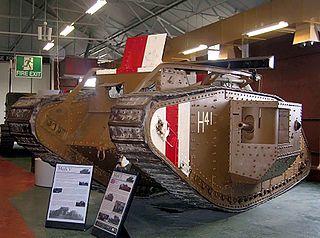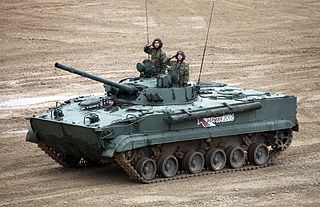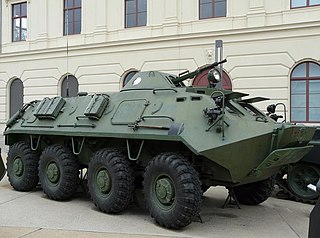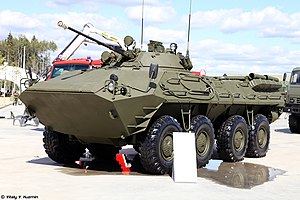
An armoured fighting vehicle or armored fighting vehicle (AFV) is an armed combat vehicle protected by armour, generally combining operational mobility with offensive and defensive capabilities. AFVs can be wheeled or tracked. Examples of AFVs are tanks, armoured cars, assault guns, self-propelled artilleries, infantry fighting vehicles (IFV), and armoured personnel carriers (APC).

An infantry fighting vehicle (IFV), also known as a mechanized infantry combat vehicle (MICV), is a type of armoured fighting vehicle used to carry infantry into battle and provide direct-fire support. The 1990 Treaty on Conventional Armed Forces in Europe defines an infantry fighting vehicle as "an armoured combat vehicle which is designed and equipped primarily to transport a combat infantry squad, and which is armed with an integral or organic cannon of at least 20 millimeters calibre and sometimes an antitank missile launcher". IFVs often serve both as the principal weapons system and as the mode of transport for a mechanized infantry unit.

The BMP-3 is a Soviet and Russian infantry fighting vehicle, successor to the BMP-1 and BMP-2. The abbreviation BMP stands for Boevaya Mashina Pekhoty.

The BMP-1 is a Soviet amphibious tracked infantry fighting vehicle that has been in service from 1966 to the present. BMP stands for Boyevaya Mashina Pyekhoty 1, meaning "infantry fighting vehicle, 1st serial model". The BMP-1 was the first mass-produced infantry fighting vehicle (IFV) of the Soviet Union. It was called the M-1967, BMP and BMP-76PB by NATO before its correct designation was known.

The BMD-1 is a Soviet airborne amphibious tracked infantry fighting vehicle (IFV), which was introduced in 1969 and first seen by the West in 1970. BMD stands for Boyevaya Mashina Desanta. It can be dropped by parachute and although it resembles the BMP-1 it is in fact much smaller. The BMD-1 was used as an IFV by the Soviet Airborne Forces (VDV). An improved variant of the BMD-1 was developed, the BMD-2. The BMD-1 also provided a basis for the BTR-D airborne multi-purpose tracked APC.

The BRDM-2 is an amphibious armoured scout car designed and developed in the Soviet Union. It was also known under the designations BTR-40PB, BTR-40P-2 and GAZ 41-08. This vehicle, like many other Soviet designs, has been exported extensively and is in use in at least 38 countries. It was intended to replace the older BRDM-1, and has improved amphibious capabilities and better armament compared to its predecessor. The BRDM-2 production continues in Poland as of 2022.

The BTR-60 is the first vehicle in a series of Soviet eight-wheeled armoured personnel carriers (APCs). It was developed in the late 1950s as a replacement for the BTR-152 and was seen in public for the first time in 1961. BTR stands for bronetransportyor.

The Dardo is an infantry fighting vehicle designed for the Italian Army as a replacement for the M113 APC. It is designed and built by the Iveco Fiat Oto Melara Syndicated Company based in Rome. Iveco is responsible for the hull and propulsion systems, while Oto Melara is responsible for the weapons and fire control systems.

The BTR-80 is an 8×8 wheeled amphibious armoured personnel carrier (APC) designed in the Soviet Union. It was adopted in 1985 and replaced the previous vehicles, the BTR-60 and BTR-70, in the Soviet Army. It was first deployed during the Soviet–Afghan War.

The BTR-D is a Soviet airborne multi-purpose tracked armoured personnel carrier. It was introduced in 1974 and first seen by the West in 1979 during the Soviet–Afghan War. BTR-D stands for Bronetransportyor Desanta. It is based on the BMD-1 airborne IFV. NATO gave it the designation BMD M1979.

The BTR-4 "Bucephalus" is an amphibious 8×8 wheeled infantry fighting vehicle (IFV) designed in Ukraine by the Kharkiv Morozov Machine Building Design Bureau.

The CM-32 "Clouded Leopard", officially Taiwan Infantry Fighting Vehicle (TIFV), is an eight-wheeled armoured vehicle currently being produced for the Republic of China Army. It is based on the 6x6 CM-31 designed by Timoney Technology Limited of Ireland and is further developed by the Ordnance Readiness Development Center.

Abhay was an Infantry Combat Vehicle created under a tech-demonstration program started in India by the Defence Research and Development Organisation or DRDO. As its first IFV project, Abhay was designed to provide experience in the construction of AFV components to DRDO, serve as a replacement to India's vast BMP fleet used in its Mechanised Infantry Regiments, and serve as a test bed for weapons and systems to be used on future vehicles, as well as to be a reference for the designs of future vehicles.

The Saur 1 is an armoured personnel carrier developed by the Romanian company ROMARM in 2006.

An armoured personnel carrier (APC) is a broad type of armoured military vehicle designed to transport personnel and equipment in combat zones. Since World War I, APCs have become a very common piece of military equipment around the world.

The Fahd is a 4x4 Egyptian armored personnel carrier, designed to fit the requirements of the Egyptian Military. It replaced older APCs in Egyptian service such as the BTR-40, and the Walid. It has been used by the United Nations.

The VPK-7829 Bumerang is a modular amphibious wheeled infantry fighting vehicle and armored personnel carrier being developed by Russian Military Industrial Company (MIC) for the Russian army.

The BMD-4 is an amphibious infantry fighting vehicle (IFV) originating from post-Cold War Russia. Originally designated as the BMD-3M, the chassis of the BMD-4 is the same as that of the BMD-3 because it was developed on the same basis. This armored fighting vehicle is one of the lightest in its class, possessing a substantial amount of firepower. The vehicle was designed to transport Russian Airborne Troops (VDV), increasing its mobility, armament, and protection on the battlefield.

The T-15 Armata, with industrial designation "Object 149", is a Russian heavy infantry fighting vehicle first seen in public in 2015 during rehearsals for the Moscow Victory Day Parade. The T-15 concept of a heavy IFV is derived from design of the BTR-T vehicle that never entered military service. As of May 2023, the T-15 Armata has not entered service and the program status is unknown.























